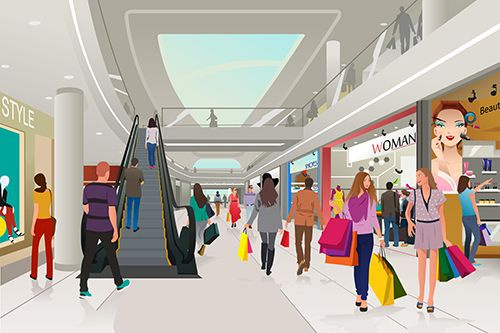The obituary of the American mall has been written for decades.
Over the last 20 years, malls around the country have closed at a rapid clip, supplanted by a shift in consumer preferences toward e-commerce options like Amazon. According to a recent report by the Wall Street Journal, there may be only 150 malls left in the United States by the end of the decade. This is down from more than 2,500 malls in the 1980s.
For many, the decline of the mall as an American institution is both palpable and personal. Like a car crash on the side of the road, the mall in decline has become a source of morbid intrigue. Millions of Americans have detailed their experiences strolling the now ghostly halls of moribund malls, many still clad in the neon color palettes and faux tropical flourishes of the 1990s. A Reddit page known as “dead malls” has more than 170,000 subscribers who share, often wistfully, photos of their once vibrant gallerias in lonely decay. It doesn’t need to be this way.

While American malls are ailing, their condition is far from terminal. With the right vision, malls across the country can be elevated once again into vibrant town squares that generate significant returns and center communal life in cities.
Doing so starts with some triage. Rather than building new properties, investors should take stock of their portfolios and seek to reposition well-established but underperforming malls in strategic locations. These facilities are often located in dense metropolitan centers, near tourist hubs, or along major roadways. Many have the site and situation for success; what they need is investment and a clear vision to bring them in line with contemporary expectations for commercial spaces.
Over the last three years, those expectations have continued to shift. Hosting a few department stores and a movie theater is no longer sufficient for a mall to draw in consistent foot traffic. Now, consumers expect entertainment and lifestyle options, novel activations, and quality dining.
In consumer surveys, Americans consistently indicate that they would like to access fitness facilities at their local malls. Yet, 10 years ago, you would be hard-pressed to find a gym at a major mall in America, largely due to REA restrictions. As owners are more amenable to alternative uses post-pandemic, there is for the first time an opportunity to make big-box gyms as much a mall staple as Abercrombie.
There is a similar demand for grocery options in mall spaces. While the grocery store and the mall—equal community essentials—were once thought of as fundamentally separate entities, research shows that Americans would prefer to be able to access groceries within their mall spaces.

These unmet needs present a significant opportunity to reimagine struggling assets for a new age and transform malls into attractive destinations for one-of-a-kind experiences. Reshuffling the tenancy of existing malls is only the beginning. Truly revitalizing the mall requires a reframing of the way investors and consumers alike view the space.
Leaders in the mall industry have long sought ways to entice customers to spend a few hours of their time—their Sunday afternoons—at their local mall. But what if we could stretch those few hours into a few days?
While this may seem fanciful, the reality of redevelopment paints a different picture. Malls are physically dominant properties with ample space. Take mixed-use housing as an example: With communities across the country facing a tight housing supply, city planners and mall operators have taken to building mixed-use housing in the immediate vicinity of repositioned malls. In some cases, they are even building units on property. This helps deliver consistent returns to investors, while also helping to create the dense, diverse communities in which many consumers, particularly younger Americans, say they would prefer to live.
The cure for the sick mall may indeed be a simple formula: redevelop, re-tenant, re-image.
Malls are the closest things that many cities have to a town square. They’re where we went on our first dates, roamed with our friends in middle school, and worked our first jobs. They’re where we shop for holiday gifts with family and congregate at restaurants on birthdays and anniversaries.
To lose the American mall would represent far more than simply the loss of a shopping center; it would tear at the fabric of the American experience. The mall is worth fighting for, and with the right approach, investors can revitalize it as a community hub for the next generation.
Bo Okoroji is founder and managing partner of Steerpoint Capital, a Black-owned real estate investment firm.













































